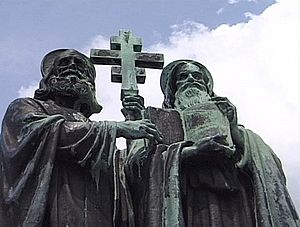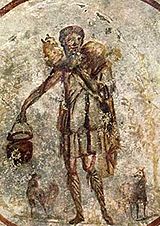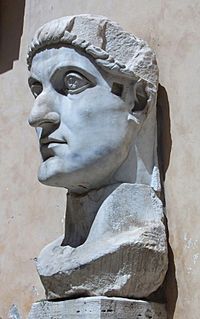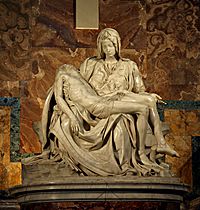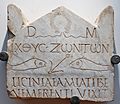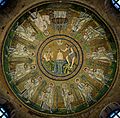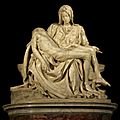History of Christianity facts for kids
The history of the Christian religion and the Christian church began with Jesus and his apostles. Christianity is the religion that is based on the birth, life, death, resurrection and teaching of Jesus Christ.
Christianity began in the 1st century AD after Jesus died, as a small group of Jewish people in Judea, but quickly spread throughout the Roman empire. Despite early persecution of Christians, it later became the state religion. In the Middle Ages it spread into Northern Europe and Russia. During the Age of Exploration, Christianity expanded throughout the world; it is currently the largest religion of the world.
The religion had schisms and theological disputes that had as result four main branches: the Roman Catholic Church, the Eastern Orthodox churches, Oriental Orthodoxy and Protestant churches.
Most of the first Christians were ethnically Jewish or Jewish proselytes. An early difficulty came from non-Jewish converts. There was the question if they had to "become Jewish" before becoming Christian. The decision of St. Peter, was that they did not, and the matter was further addressed with the Council of Jerusalem.
The doctrines of the apostles brought the Early Church into conflict with some Jewish religious authorities, and this eventually led to the martyrdom of SS. Stephen and James the Great and expulsion from the synagogues. Thus, Christianity got an identity distinct from Judaism. The name "Christian" (Greek Χριστιανός) was first used for the disciples in Antioch, as recorded in (Acts 11:26).
Contents
- Worship of Jesus Christ
- Jewish continuity
- Post-Apostolic Church
- Christianity legalized
- Church of the Early Middle Ages (476 – 800)
- Church of the High Middle Ages (800 – 1499)
- Church and the Italian Renaissance (1399 – 1599)
- Protestant Reformation (1521 – 1579)
- Counter-Reformation
- Images for kids
- See also
Worship of Jesus Christ
Sources for the beliefs of the apostolic community include the Gospels and New Testament Epistles. The very earliest reports are in these texts: early Christian creeds and hymns and reports about the Passion, the empty tomb, and appearances of Jesus after his Resurrection. There are reasons to suppose that they were written within a few years of the crucifixion of Jesus and came from the Jerusalem Church.
Jewish continuity
Christianity kept many practices from Jewish tradition. Christianity thought the Jewish scriptures to be sacred and used mostly the Septuagint translation of the Torah (the first five books of the Old Testament), the Hebrew Prophets and Writings (the rest of the Old Testament books), and added other texts as the New Testament. Christians professed Jesus to be the God of Israel, having taken human form, and considered Jesus to be the Messiah (Christ) who had been prophesied about in the Old Testament and so was expected by the people of Israel.
Christianity continued many Judaic practices: liturgical worship, including the use of incense, an altar, a set of scriptural readings adapted from synagogue practice, use of sacred music in hymns and prayer, and a religious calendar, as well as other typical features: an exclusively male priesthood, and ascetic practices (fasting etc.).
Post-Apostolic Church
The time when most of the apostles had died and their jobs as leaders of the Christian communities in the cities had been taken over by bishops, is called post-apostolic period. It includes the time of persecutions until Christian worship was legalized under Constantine the Great. The earliest recorded use of the term Christianity (Greek Χριστιανισμός) is from this period. The term was used by Ignatius of Antioch c. 107.
Persecutions
Early Christians were subject to various persecutions. This meant even death. Early martyrs included Stephen (Acts 7:59) and James, son of Zebedee (Acts 12:2). Persecutions in larger scale by the authorities of the Roman Empire began with the year 64, when the Emperor Nero blamed them for the great Fire of Rome as the Roman historian Tacitus reported.
According to Church tradition, it was under Nero's persecution that the saints Peter and Paul became martyrs in Rome. Several of the New Testament writings mention persecutions and very difficult times. For 250 years there were times when Christians suffered from persecutions, because they refused to worship the Roman emperor. That was seen as treason and punished by execution. But the Christian religion continued to spread throughout the Mediterranean region. In the late fourth century they became the dominant religious force of the Roman Empire.
Christianity legalized
Galerius issued an edict permitting the practice of the Christian religion in April of 311. In 313 Constantine I and Licinius announced toleration of Christianity in the Edict of Milan. Constantine became the first Christian emperor; he had learnt about Christianity from his mother, Helena.
By 391, under the reign of Theodosius I, Christianity had become the state religion of Rome. When Christianity was legalized the Church took the same provinces for administration as the imperial government and called them dioceses. The Bishop of Rome claimed to be the highest amongst all others and chose the title pope.
During this era, there were several Ecumenical Councils. These were mostly concerned with Christological disputes. The two Councils of Niceaea (324, 382) condemned Arianism and produced the Nicene Creed to define the faith. The Council of Ephesus condemned Nestorianism and affirmed the Blessed Virgin Mary to be Theotokos ("God-bearer" or "Mother of God"). Perhaps the most important was the Council of Chalcedon that affirmed that Christ had two natures, fully God and fully man, at the same time. That meant that Monophysitism was condemned.
Church of the Early Middle Ages (476 – 800)
The Church in the Early Middle Ages saw a "transformation of the Roman world" rather than a "fall of the Roman Empire". With the Muslim invasions of the seventh century, the Western (Latin) and Eastern (Greek) areas of Christianity began to take on distinctive shapes, and the Bishops of Rome were more interested in barbarian kings than in the Byzantine Emperors. This led to the coronation of Charlemagne as "Emperor of the Romans" by Pope Leo III in Rome on Christmas Day, 800.
Early Medieval Papacy
The city of Rome was affected very much by warfare in Italy during the Early Middle Ages. Emperor Justinian I conquered the Italian kingdom of the Ostrogoths. He made Ravenna, Italy a territory with its own governor, but imperial influence was often limited. After the invasion of the Lombards, Rome had to take care of itself. Thus the popes, out of necessity, found themselves feeding the city with grain from papal estates, negotiating treaties, paying protection money to Lombard warlords, and, failing that, hiring soldiers to defend the city. Eventually, the failure of the Empire to send aid resulted in the popes turning for support from other sources, most especially the Franks.
Church of the High Middle Ages (800 – 1499)
The High Middle Ages is the period from the coronation of Charlemagne in 800 to the close of the fifteenth century, which saw the fall of Constantinople (1453), the end of the Hundred Years' War (1453), the discovery of the New World (1492), and thereafter the Protestant Reformation (1515).
Crusades
The Crusades were a military conflicts conducted by Christian knights for the defense of Christians and for the expansion of Christian domains. Generally, the crusades refer to the campaigns in the Holy Land against Muslim forces sponsored by the Papacy. There were other crusades against Islamic forces in southern Spain, southern Italy, and Sicily, as well as the campaigns of Teutonic knights against pagan strongholds in Eastern Europe, and (to a much lesser extent) crusades against Catharism or other Christian heresies.
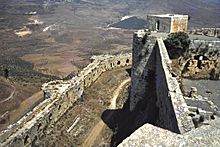
The Holy Land had been part of the Roman Empire, and thus Byzantine Empire, until the Islamic conquests of the seventh and eighth centuries. Thereafter, Christians had generally been permitted to visit the sacred places in the Holy Land until 1071, when the Seljuk Turks closed Christian pilgrimages and assailed the Byzantines, defeating them at the Battle of Manzikert. Emperor Alexius I asked for aid from Pope Urban II (1088-1099) for help against Islamic aggression. Instead of sending money, Urban II called upon the knights of Christendom in a speech made at the Council of Clermont on 27 November 1095, combining the idea of pilgrimage to the Holy Land with that of waging a holy war against infidels.
East-West Schism
The East-West Schism, or Great Schism, separated the Church into Western (Latin) and Eastern (Greek) branches, i.e. Western Catholicism and Eastern Orthodoxy. It was the first major division since certain groups in the East rejected the decrees of the Council of Chalcedon (see Oriental Orthodoxy), and was far more significant. Though normally dated to 1054, the East-West Schism was the result of an long time of disagreement between Latin and Greek Christendom over papal primacy and certain doctrinal matters like the filioque. Bad feelings were intensified by cultural and linguistic differences.
The schism became "official" in 1054 when the Pope's legates notified Patriarch Michael Cerularius of Constantinople that he had been excommunicated. A few days later, he excommunicated the legates. Attempts at reconciliation were made in 1274 in Lyon and in 1439 in Basel, but in each case the eastern hierarchs who agreed to the unions were repudiated by the Orthodox as a whole. However, reconciliation was achieved between the West and what are now called the "Eastern Rite Catholic Churches". More recently, in 1965 the mutual excommunications were rescinded by the Pope and the Patriarch of Constantinople, though schism remains.
Both groups are descended from the Early Church, both acknowledge the apostolic succession of each other's bishops, and the validity of each other's sacraments. Though both acknowledge the primacy of the Bishop of Rome, Eastern Orthodoxy understands this as a primacy of honor with limited or no ecclesiastical authority in other dioceses.
Western Schism
The Western Schism, or Papal Schism, was a prolonged period of crisis in Latin Christendom from 1378 to 1416, when there were two or more claimants to the See of Rome and thus it was difficult to discern who the true Pope was. The conflict was political, rather than doctrinal, in nature.
Church and the Italian Renaissance (1399 – 1599)
The Renaissance was a period of great cultural change and achievement, marked in Italy by a classical orientation and an increase of wealth through mercantile trade. The City of Rome, the Papacy, and the Papal States were all affected by the Renaissance. On the one hand, it was a time of great artistic patronage and architectural magnificence, where the Church patroned such artists as Michelangelo, Brunelleschi, Bramante, Raphael, Fra Angelico, Donatello, and da Vinci. On the other hand, wealthy Italian families often secured episcopal offices, including the papacy, for their own members, some of whom were known for immorality, such as Alexander VI and Sixtus IV.
Protestant Reformation (1521 – 1579)
In the early 16th century, movements were begun by two theologians, Martin Luther and Ulrich Zwingli, that aimed to reform the Church. Unlike earlier reformers they considered the root of corruptions to be doctrinal (rather than simply a matter of moral weakness or lack of ecclesiastical discipline) and thus they aimed to change contemporary doctrines to fit their idea of the "true gospel". The Protestant Reformation is so called because the movement's leaders "protested" against the ecclesiastical hierarchy and the pope, essentially electing to institute their reforms separately from it. The term "Protestant", however, was not originally used by these leaders; instead, they called themselves "evangelical", emphasizing the "return to the true gospel (Greek: euangelion)".
The beginning of the Protestant Reformation is generally identified with Martin Luther and the posting of the 95 Theses in 1517 in Wittenburg, Germany. Early protest was against corruptions such as simony, episcopal vacancies, and the sale of indulgences. The Protestant position, however, would come to incorporate doctrinal changes such as sola scriptura and sola fide. The three most important traditions to emerge directly from the Protestant Reformation were the Lutheran, Reformed (Calvinist, Presbyterian, etc.), and Anglican traditions, though the latter group identifies as both "Reformed" and "Catholic", and some subgroups reject the classification as "Protestant".
The Protestant Reformation may be divided into two distinct but basically simultaneous movements, the Magisterial Reformation and the Radical Reformation. The Magisterial Reformation involved the alliance of certain theological teachers (Latin: magistri) such as Luther, Huldrych Zwingli, John Calvin, Cranmer, etc. with secular magistrates who cooperated in the reformation of Christendom. Radical Reformers, besides forming communities outside state sanction, often employed more extreme doctrinal change, such as the rejection of tenants of the Councils of Nicaea and Chalcedon. Often the division between magisterial and radical reformers was as or more violent than the general Catholic and Protestant hostilities.
The Protestant Reformation spread almost entirely within the confines of Northern Europe, but did not take hold in certain northern areas such as Ireland and parts of Germany. By far the magisterial reformers were more successful and their changes more widespread than the radical reformers. The Catholic response to the Protestant Reformation is known as the Counter Reformation, or Catholic Reformation, which resulted in a reassertion of traditional doctrines and the emergence of new religious orders aimed at both moral reform and new missionary activity. The Counter Reformation reconverted approximately 33% of Northern Europe to Catholicism and initiated missions in South and Central America, Africa, Asia, and even China and Japan. Protestant expansion outside of Europe occurred on a smaller scale through colonization of North America and areas of Africa.
Martin Luther
Martin Luther was an Augustinian friar and professor at the University of Wittenberg. In 1517, he published a list of 95 Theses, or points to be debated, concerning the illicitness of selling indulgences. Luther had a particular disdain for Aristotelian philosophy, and as he began developing his own theology, he increasingly came into conflict with other scholars. Soon, Luther began to develop his theology of justification, or process by which one is "made right" (righteous) in the eyes of God.
In Catholic theology, one is made righteous by a progressive infusion of grace accepted through faith and cooperated with through good works. Luther's doctrine of justification was different. He said justification meant "the declaring of one to be righteous", where God imputes the merits of Christ upon one who remains without inherent merit. In this process, good works are more of an unessential byproduct that contribute nothing to one's own state of righteousness. Conflict between Luther and leading theologians lead to his gradual rejection of authority of the Church hierarchy. In 1520, he was condemned for heresy by the papal bull Exsurge Domine, which he burned at Wittenburg along with books of canon law.
John Calvin
John Calvin was a French cleric and doctor of law turned Protestant reformer in the second generation of the Reformation. He was well known for publishing the Institutes of the Christian Religion, in 1536 (later revised), and became a leader of the Reformed church in Geneva, which became an "unofficial capital" of Reformed Christianity in the second half of the sixteenth century. He had great authority in the city and over the city council, such that he has (rather ignominiously) been called a "Protestant pope".
Calvin established an eldership together with a "consistory", where pastors and the elders established matters of religious discipline for the Genevan population. Calvin's theology is best known for his doctrine of (double) predestination, which held that God had, from all eternity, providentially foreordained who would be saved (the elect) and likewise who would be damned (the reprobate). Predestination was not the dominant idea in Calvin's works, but it would seemingly become so for many of his Reformed successors.
English Reformation
Unlike other reform movements, the English Reformation began by royal influence. Henry VIII considered himself a thoroughly Catholic King, and in 1521 he defended the papacy against Luther in a book he commissioned entitled, The Defense of the Seven Sacraments, for which Pope Leo X awarded him the title Fidei Defensor (Defender of the Faith). However, the king came into conflict with the papacy when he wished to annul his marriage with Catherine of Aragon, for which he needed papal sanction. Catherine, among many other noble relations, was the aunt of Emperor Charles V, the papacy's most significant secular supporter. The ensuing dispute eventually lead to a break from Rome and the declaration of the King of England as head of the English (Anglican) Church. England then experienced a period of frenetic and eclectic reforms, some more radical and others more traditional, under monarchs such as Edward VI and Elizabeth I, and Archbishops of Canterbury such as Thomas Cranmer and William Laud. What emerged was a state church that considered itself both "Reformed" and "Catholic" but not "Roman" (and hesitated from the title "Protestant"), and other "unofficial" more radical movements such as the Puritans.
Counter-Reformation
The Counter-Reformation, or Catholic Reformation, was the response of the Catholic Church to the Protestant Reformation. The essence of the Counter-Reformation was a renewed conviction in traditional practices and the upholding of Catholic doctrine as the source of ecclesiastic and moral reform, and the answer to halting the spread of Protestantism. Thus it experienced the founding of new religious orders, such as the Jesuits, the establishment of seminaries for the proper training of priests, renewed worldwide missionary activity, and the development of new yet orthodox forms of spirituality, such as that of the Spanish mystics and the French school of spirituality. The entire process was spearheaded by the Council of Trent, which clarified and reasserted doctrine, issued dogmatic definitions, and produced the Roman Catechism.
Though Ireland, Spain, France, and elsewhere featured significantly in the Counter-Reformation, its heart was Italy and the various popes of the time, who established the Index Librorum Prohibitorum (the list of prohibited books) and the Roman Inquisition, a system of juridical tribunals that prosecuted heresy and related offences. The Papacy of St. Pius V (1566-1572) was known not only for its focus on halting heresy and worldly abuses within the Church, but also for its focus on improving popular piety in a determined effort to stem the appeal of Protestantism. Pius began his pontificate by giving large alms to the poor, charity, and hospitals, and the pontiff was known for consoling the poor and sick, and supporting missionaries. The activities of these pontiffs coincided with a rediscovery of the ancient Christian catacombs in Rome. As Diarmaid MacCulloch stated, "Just as these ancient martyrs were revealed once more, Catholics were beginning to be martyred afresh, both in mission fields overseas and in the struggle to win back Protestant northern Europe: the catacombs proved to be an inspiration for many to action and to heroism."
Great Awakenings
The First Great Awakening was a wave of religious enthusiasm among Protestants in the American colonies c. 1730-1740, emphasizing the traditional Reformed virtues of Godly preaching, rudimentary liturgy, and a deep sense of personal guilt and redemption by Christ Jesus. Historian Sydney E. Ahlstrom saw it as part of a "great international Protestant upheaval" that also created Pietism in Germany, the Evangelical Revival, and Methodism in England. It centered on reviving the spirituality of established congregations, and mostly affected Congregational, Presbyterian, Dutch Reformed, German Reformed, Baptist, and Methodist churches, while also spreading within the slave population. The Second Great Awakening (1800–1830s), unlike the first, focused on the unchurched and sought to instill in them a deep sense of personal salvation as experienced in revival meetings. It also sparked the beginnings of Restorationist groups such as the Mormons and the Holiness movement. The Third Great Awakening began from 1857 and was most notable for taking the movement throughout the world, especially in English speaking countries. The final group to emerge from the "great awakenings" in North America was Pentecostalism, which had its roots in the Methodist, Wesleyan, and Holiness movements, and began in 1906 on Azusa Street, in Los Angeles. Pentecostalism would later lead to the Charismatic movement.
Restorationism
Restorationism refers to various unaffiliated movements that considered contemporary Christianity, in all its forms, to be a deviation from the true, original Christianity, which these groups then attempted to "Reconstruct", often using the Book of Acts as a "guidebook" or sorts. Restorationism developed out of the Second Great Awakening and is historically connected to the Protestant Reformation, but differs in that Restorationists do not usually describe themselves as "reforming" a Christian church continuously existing from the time of Jesus, but as restoring the Church that they believe was lost at some point. The name Restoration is also used to describe the Latter-day Saints (Mormons) and the Jehovah's Witness Movement.
Fascism
Fascism describes certain related political regimes in 20th century Europe, especially Nazi Germany. When the Italian government closed Catholic youth organizations, Pope Pius XI issued the encyclical Non Abbiamo Bisogno, saying that Fascist governments had hidden "pagan intentions" and expressed the irreconcilability of the Catholic position and Fascism, which placed the nation above God and fundamental human rights and dignity. He later signed agreements with the new rulers of Italy and Germany.
Many Catholic priests and monastics were persecuted under the Nazi regime, such as the concentration camp victims Maximilian Kolbe and Edith Stein (Saint Teresa Benedicta of the Cross). Furthermore, many Catholic laypeople and clergy helped in sheltering Jews during the Holocaust, including Pope Pius XII. Various incidents, such as giving aid to downed Allied airmen, nearly caused Nazi Germany to invade the Vatican before the liberation of Rome in 1944.
The relationship between Nazism and Protestantism, especially the German Lutheran Church, is complex. Though the majority of Protestant church leaders in Germany made little comment on the Nazis' growing anti-Jewish activities, some, such as Dietrich Bonhoeffer (a Lutheran pastor) were strongly opposed to the Nazis. Bonhoeffer was later found guilty in the conspiracy to assassinate Hitler and executed.
Fundamentalism
Fundamentalist Christianity, is a movement that arose mainly within British and American Protestantism in the late 19th and early 20th centuries in reaction to modernism and certain liberal Protestant groups that denied doctrines considered fundamental to Christianity yet still called themselves "Christian". Thus, fundamentalism sought to reestablish tenants that could not be denied without relinquishing a Christian identity, the "fundamentals": the Bible as God`s word, viewed as the sole source of authority, the virgin birth of Christ, the doctrine of atonement through Jesus, the bodily resurrection of Jesus, and the imminent return of Christ.
Ecumenism
Ecumenism broadly refers to movements between Christian groups to establish a degree of unity through dialogue. "Ecumenism" is derived from Greek οἰκουμένη (oikoumene), which means "the inhabited world", but more figuratively something like "universal oneness". The movement can be distinguished into Catholic and Protestant movements, with the latter characterized by a redefined ecclesiology of "denominationalism" (which the Catholic Church, among others, rejects).
Concerning the Greek Orthodox Church, steady movement was made to reconcile the East-West Schism. On 30 November 1894, Pope Leo XIII publishes the Apostolic Letter Orientalium Dignitas (On the Churches of the East) safeguarding the importance and continuance of the Eastern traditions for the whole Church. On 7 December 1965, a Joint Catholic-Orthodox Declaration of His Holiness Pope Paul VI and the Ecumenical Patriarch Athenagoras I was issued lifting the mutual excommunications of 1054.
Concerning Catholic relations with Protestant communities, certain commissions were established to foster dialogue and documents have been produced aimed at identifying points of doctrinal unity, such as the Joint Declaration on the Doctrine of Justification produced with the Lutheran World Federation in 1999.
Ecumenical movements within Protestantism have focused on determining a list of doctrines and practices essential to being Christian and thus extending to all groups which fulfill these basic criteria a (more or less) equal status, with perhaps one's own group still retaining a "first among equal" standing. This process involved a redefinition of the idea of "the Church" from traditional theology. This ecclesiology, known as denominationalism, contends that each group (which fulfills the essential criteria of "being Christian") is a sub-group of a greater "Christian Church", itself a purely abstract concept with no direct representation, i.e. no group, or "denomination", claims to be "the Church". Obviously, this ecclesiology it at variance with other groups that indeed consider themselves to be "the Church". But moreover, because the "essential criteria" generally consist of belief in the holy Trinity, it has resulted in strife between these Protestant ecumenical movements and non-Trinitarian groups such as Latter-day Saints (Mormons) and Jehovah's Witnesses, which are not often not regarded as Christian by these ecumenical groups.
Images for kids
-
Funerary stele of Licinia Amias on marble, in the National Roman Museum. One of the earliest Christian inscriptions found, it comes from the early 3rd century Vatican necropolis area in Rome. It contains the text ΙΧΘΥϹ ΖΩΝΤΩΝ ("fish of the living"), a predecessor of the Ichthys symbol.
-
The eastern Mediterranean region in the time of Paul the Apostle
-
St. Lawrence (martyred 258) before Emperor Valerianus by Fra Angelico
-
A folio from Papyrus 46, an early-3rd-century collection of Pauline epistles
-
Early centers of Christianity to AD 325 Spread of Christianity to AD 600
-
Icon depicting the Emperor Constantine (centre) and the bishops of the First Council of Nicaea (325) holding the Niceno–Constantinopolitan Creed of 381.
-
Imagined portrait of Arius; detail of a Cretan School icon, c. 1591, depicting the First Council of Nicaea.
-
The ceiling mosaic of the Arian Baptistery, built in Ravenna by the Ostrogothic King Theodoric the Great.
-
An Eastern Roman mosaic showing a basilica with towers, mounted with Christian crosses, 5th century, Louvre
-
Coptic icon of St. Anthony the Great, father of Christian monasticism and early anchorite. The Coptic inscription reads ‘Ⲡⲓⲛⲓϣϯ Ⲁⲃⲃⲁ Ⲁⲛⲧⲱⲛⲓ’ ("the Great Father Anthony").
-
A mosaic of Justinian I in the Basilica of San Vitale, Ravenna, Italy
-
"Hospitality of Abraham", icon by Andrei Rublev; the three angels represent the Godhead according to Trinitarian Christians.
-
Western Europe, the Holy Roman Empire, Kievan Rus', and the Byzantine Empire in the Middle Ages (year 1000)
-
Jan Hus defending his theses at the Council of Constance (1415), painting by the Czech artist Václav Brožík
-
Michelangelo's Pietà (1498–99) in St. Peter's Basilica, Vatican City
-
Philipp Spener, the founder of Pietism
-
Churches of the Moscow Kremlin, as seen from the Balchug
-
Demolition of the Cathedral of Christ the Saviour in Moscow on the orders of Joseph Stalin, 5 December 1931, consistent with the doctrine of state atheism in the USSR
-
Laying on of hands during a service in a neo-charismatic church in Ghana
See also
 In Spanish: Historia del cristianismo para niños
In Spanish: Historia del cristianismo para niños


